The ADS8588H supports
the oversampling mode of operation using an on-chip averaging digital filter, as
explained in the Digital Filter and Noise section. The device can be configured in oversampling mode by the OS[2:0]
pins (see the OS[2:0] section). Figure 7-20 shows a typical timing diagram for the oversampling mode of operation. The input
on the OS pins is latched on the falling edge of the BUSY signal to configure the
oversampling rate for the next conversion.
In the oversampling mode of operation,
both the CONVSTA and CONVSTB signals must be tied together or driven together. The
BUSY signal width varies with the OSR setting because the conversion time increases
with increase in OSR, as shown in Figure 7-20. The high time for the BUSY signal increases with the OSR setting, as listed in
the Timing Requirements: CONVST ControlTiming Requirements: CONVST Control table.
For any particular OSR setting, the
maximum achievable throughput per channel is specified in Table 7-1. If the application is running at a lower throughput, then a higher OSR setting
can be selected for further noise reduction and SNR improvement. To maximize the
throughput per channel, perform a data read when BUSY is high and a conversion is
ongoing in OSR mode. This process enables data read for the previous conversion (see
the Data Read During Conversion section). At the falling edge of the BUSY signal, the internal data
registers are updated with the new conversion data; thus the read operation must
complete and CS must be pulled high for at least
tDZ_CSBSY before BUSY goes low (see the Timing Requirements: Data Read OperationTiming Requirements: Data Read OperationTiming Requirements: Data Read Operation table).
Oversampling
the input signal reduces noise during the conversion process, thus reducing the
histogram code spread for a dc input signal to the ADC. Figure 7-21 to Figure 7-26 show the effect of oversampling on the output code spread in a dc histogram
plot.
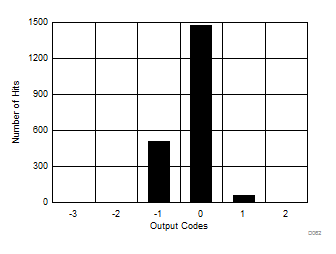
| Mean
= –0.22, sigma = 0.48 |
Figure 7-21 DC
Histogram for OSR2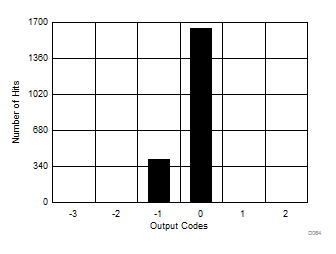
| Mean
= –0.49, sigma = 0.36 |
Figure 7-23 DC
Histogram for OSR8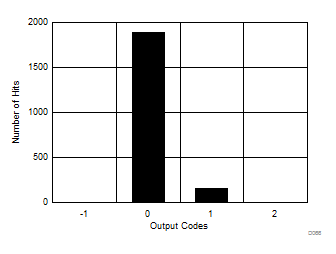
| Mean
= 0.13, sigma = 0.31 |
Figure 7-25 DC
Histogram for OSR32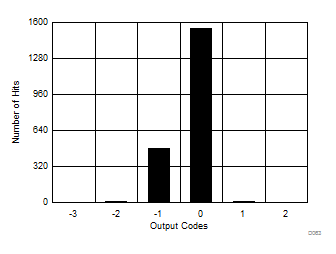
| Mean
= –0.43, sigma = 0.41 |
Figure 7-22 DC
Histogram for OSR4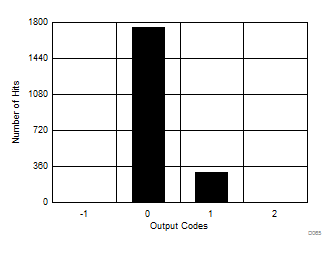
| Mean
= 0.49, sigma = 0.33 |
Figure 7-24 DC
Histogram for OSR16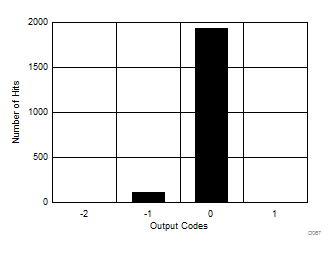
| Mean
= –0.21, sigma = 0.30 |
Figure 7-26 DC
Histogram for OSR64In OSR modes, the device adds a
digital filter at the output of the ADC. The digital filter affects the frequency
response of the entire data acquisition system including the internal low-pass
analog filter and the oversampling digital filter. Figure 7-27 to Figure 7-32 show the frequency response curves for different OSR settings in the ±10-V
range.
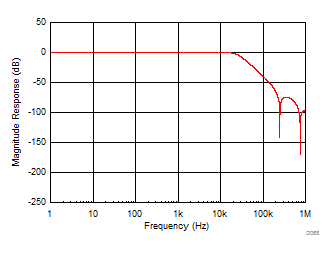
| AVDD
= 5 V, DVDD = 5 V, TA = 25°C, input range =
±10 V |
Figure 7-27 Digital Filter Response for OSR = 2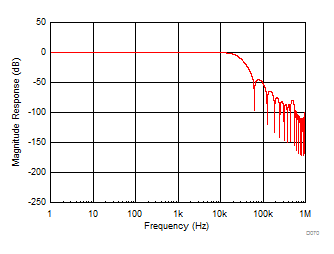
| AVDD
= 5 V, DVDD = 5 V, TA = 25°C, input range =
±10 V |
Figure 7-29 Digital Filter Response for OSR = 8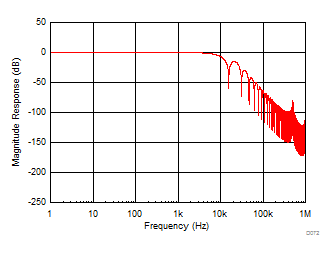
| AVDD
= 5 V, DVDD = 5 V, TA = 25°C, input range =
±10 V |
Figure 7-31 Digital Filter Response for OSR = 32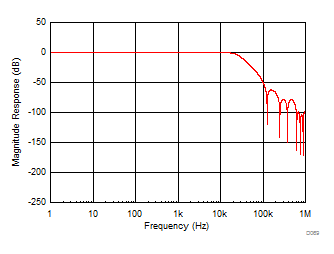
| AVDD
= 5 V, DVDD = 5 V, TA = 25°C, input range =
±10 V |
Figure 7-28 Digital Filter Response for OSR = 4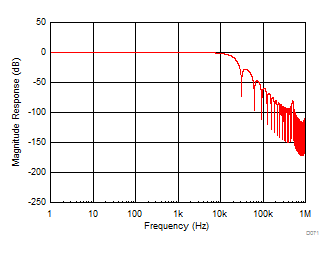
| AVDD
= 5 V, DVDD = 5 V, TA = 25°C, input range =
±10 V |
Figure 7-30 Digital Filter Response for OSR = 16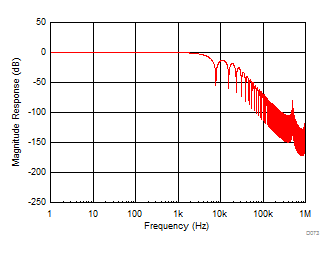
| AVDD
= 5 V, DVDD = 5 V, TA = 25°C, input range =
±10 V |
Figure 7-32 Digital Filter Response for OSR = 64
 Figure 7-20 OSR Mode
Operation Timing Diagram
Figure 7-20 OSR Mode
Operation Timing Diagram










